Experimental and Numerical Investigation of a New Type of Composite Slab with a Separate Joint
Abstract
:1. Introduction
2. Experimental Investigation
2.1. Specimen and Material Property
2.2. Testing Setup, Instrument, and Loading Protocol
3. Test Results
3.1. Crack Pattern Observations
3.2. Load—Deformation Behavior
3.3. Evaluation of Flexural Performance
4. Finite Element Analysis
4.1. Material Model
4.2. Interaction Setting
4.3. Mesh Generation, Boundary, and Loading Conditions
4.4. Verification of FEM
5. Conclusions
- (1)
- The cracking load of this composite slab with a separate joint was 5.0 kN/m2. When the load increased to 5.5 kN/m2, both the crack width and midspan deflection were below the specified limits for crack width and deflection at the normal serviceability limit state according to the GB50010-2010. This indicates that the composite slab can be employed in different architecture categories, such as residential, commercial, and storage rooms, meeting engineering requirements.
- (2)
- The cracking load at the bottom gap of the composite slab was 5.0 kN/m2, and the cracking load of the precast plank was 6.5 kN/m2. The similar cracking loads of the two indicate that the use of PE rods, mortar, and alkali-resistant mesh fabric can provide sufficient crack resistance.
- (3)
- When the load was applied to 13.95 kN/m2, the crack width was 0.8 mm and greater than 0.3 mm (the limit value of cracks under the normal service limit state specified in GB50010-2010), indicating that the normal service limit state of this composite slab with a separate joint was controlled by the crack width.
- (4)
- During the entire loading process, there was no significant sliding observed between the precast plank and the concrete topping. Therefore, for the design of the new type of composite slab with a separated joint, it is recommended that the length of the horizontal interface should not be less than 250 mm, and the length of the lap splices should also not be less than 250 mm to ensure the integrity of the joint.
- (5)
- The finite element model developed in this study can accurately predict the mechanical performance of the new type of composite slab with a separate joint.
Author Contributions
Funding
Data Availability Statement
Conflicts of Interest
References
- Park, R. A perspective on the seismic design of precast concrete structures in New Zealand. PCI J. 1995, 40, 40–60. [Google Scholar] [CrossRef]
- Chong, X.; Xie, L.L.; Ye, X.G.; Jiang, Q.; Wang, D.C. Experimental study on the seismic performance of superimposed RC shear walls with enhanced horizontal joints. J. Earthq. Eng. 2019, 23, 1–17. [Google Scholar] [CrossRef]
- Nie, J.G.; Jiang, Y.X.; Nie, X.; Zhuang, L.D. Effect of truss reinforcement on mechanical properties of prefabricated slabs. J. Build. Struct. 2021, 42, 151–158. [Google Scholar]
- Lou, F.; Chen, X.L.; Luo, B.; Chen, Z. Mechanical behavior of a new type of reinforced concrete composite slab with a joint. Case. Stud. Constr. Mater. 2024, 20, e02773. [Google Scholar]
- Yun, Y.C.; Jiang, J.F.; Chen, P. Flexural behavior of lattice girder slabs with different connections: Experimental study. Adv. Civ. Eng. 2022, 2022, 7722668. [Google Scholar] [CrossRef]
- Wu, F.B.; Liu, B.; Li, J.; Deng, L.B.; Huang, L. Experimental study and finite element analysis of structural measures for joints between new type of superposed slabs. Ind. Constr. 2015, 45, 50–56+75. [Google Scholar]
- Ye, X.G.; Hua, H.G.; Xu, T.S.; Wang, D.C. Experimental study on connections of superimposed slabs. Ind. Constr. 2010, 40, 59–63. [Google Scholar]
- Ye, X.G.; Yang, K.N.; Chong, X. Experimental study on properties of side joint between superimposed slabs with lattice steel bars. Appl. Mech. Mater. 2014, 638, 109–114. [Google Scholar]
- Wang, Y.R. Experiment Study and Numerical Simulation Analysis on Bending Performance of Side Stitched Reinforced Concrete Superimposed Slab. Master’s Thesis, Hefei University of Technology, Hefei, China, 2014. [Google Scholar]
- Liu, Y.L.; Huang, J.Q.; Chong, X.; Ye, X.G. Experimental investigation on flexural performance of semi-precast reinforced concrete one-way slab with joint. Struct. Concr. 2021, 22, 2243–2257. [Google Scholar] [CrossRef]
- Yu, Y.T.; Zhao, Y.; Gao, Z.Q. Experimental research on flexural behavior of reinforced concrete composite slab connected without gap. J. Build. Struct. 2019, 49, 29–37. [Google Scholar]
- Xiao, T.; Zhang, M.S.; Li, B.Y.; Xu, Q.B.; Gong, S.F. Experimental study on flexural performance of composite slab with groove splicing joint. J. Zhejiang Univ. 2023, 57, 842–854. [Google Scholar]
- Kim, D.W.; Shim, C.S. Crack width control on concrete slab using half-depth precast panels with loop joints. J. Korean. Soc. Civ. Eng. 2015, 35, 19–29. [Google Scholar] [CrossRef]
- Zhang, X.F.; Li, H.M.; Liang, S.X.; Zhang, H. Experimental and numerical study of lattice girder composite slabs with monolithic joint. Crystals 2021, 11, 219. [Google Scholar] [CrossRef]
- Zhang, X.F.; Zheng, S.G.; Shan, Y.C.; Zhou, X.Y.; Chen, D. Experimental study on full-scale steel bar truss superimposed two-way slabs without extending reinforcement on all sides and connected without gap. Build. Struct. 2019, 49, 83–87. [Google Scholar]
- Stehle, J.; Kanellopoulos, A.; Karihaloo, B.L. Performance of joints in reinforced concrete slabs for two-way spanning action. Proc. ICE-Struct. Build. 2011, 164, 197–209. [Google Scholar] [CrossRef]
- Altoubat, S.; Ousmane, H.; Barakat, S. Experimental study of in-plane shear behavior of fiber-reinforced concrete composite slabs. J. Struct. Eng. 2016, 142, 1–11. [Google Scholar] [CrossRef]
- JGJ1-2014; Technical Specification for Precast Concrete Structures. China Architecture & Building Press: Beijing, China, 2014.
- GB/T 50081-2019; Standard for Test Method of Concrete Physical and Mechanical Properties. China Architecture & Building Press: Beijing, China, 2019.
- GB/T 228.1-2010; Metallic Materials: Tensile Testing: Part 1: Method of Test at Room Temperature. Standards Press of China: Beijing, China, 2010.
- GB/T 50152-2012; Standard for Test Method of Concrete Structures. Architecture & Building Press: Beijing, China, 2012.
- GB5009-2012; Load Code for the Design of Building Structures. Architecture & Building Press: Beijing, China, 2012.
- GB50010-2010; Code for Design of Concrete Structures. Architecture & Building Press: Beijing, China, 2010.
- Genikomsou, A.S.; Polak, M.A. Finite element analysis of punching shear of concrete slabs using damaged plasticity model in ABAQUS. Eng. Struct. 2015, 98, 38–48. [Google Scholar] [CrossRef]
- Sidoroff, F. Physic Nonlinearities in Structural Analysis; Springer: Berlin/Heidelberg, Germany, 1981. [Google Scholar]
- Liu, J.P.; Lai, Z.C.; Chen, B.C.; Xu, S. Experimental behavior and analysis of steel-laminated concrete (RC and UHPC) composite girders. Eng. Struct. 2020, 225, 111240. [Google Scholar] [CrossRef]
- ACI. Building Code Requirements for Structural Concrete and Commentary; ACI Committee: Hong Kong, China, 1995; p. 318. [Google Scholar]
- Luo, B. Research on Designing Theory and Experimental among Flexural Performance of Precast Concrete Composite Slabs with Different Shapes. Ph.D. Thesis, Xi’an University of Architecture and Technology, Xi’an, China, 2019. [Google Scholar]
- Ma, X. Experimental Study on Flexural Behavior of Long-Span Laminated Slabs with Precast Composite Panel. Master’s Thesis, Xi’an University of Architecture and Technology, Xi’an, China, 2020. [Google Scholar]
- Chen, A.; Yossef, M.; Hopkins, P. A comparative study of different methods to calculate degrees of composite action for insulated concrete sandwich panels. Eng. Struct. 2020, 212, 110423. [Google Scholar] [CrossRef]
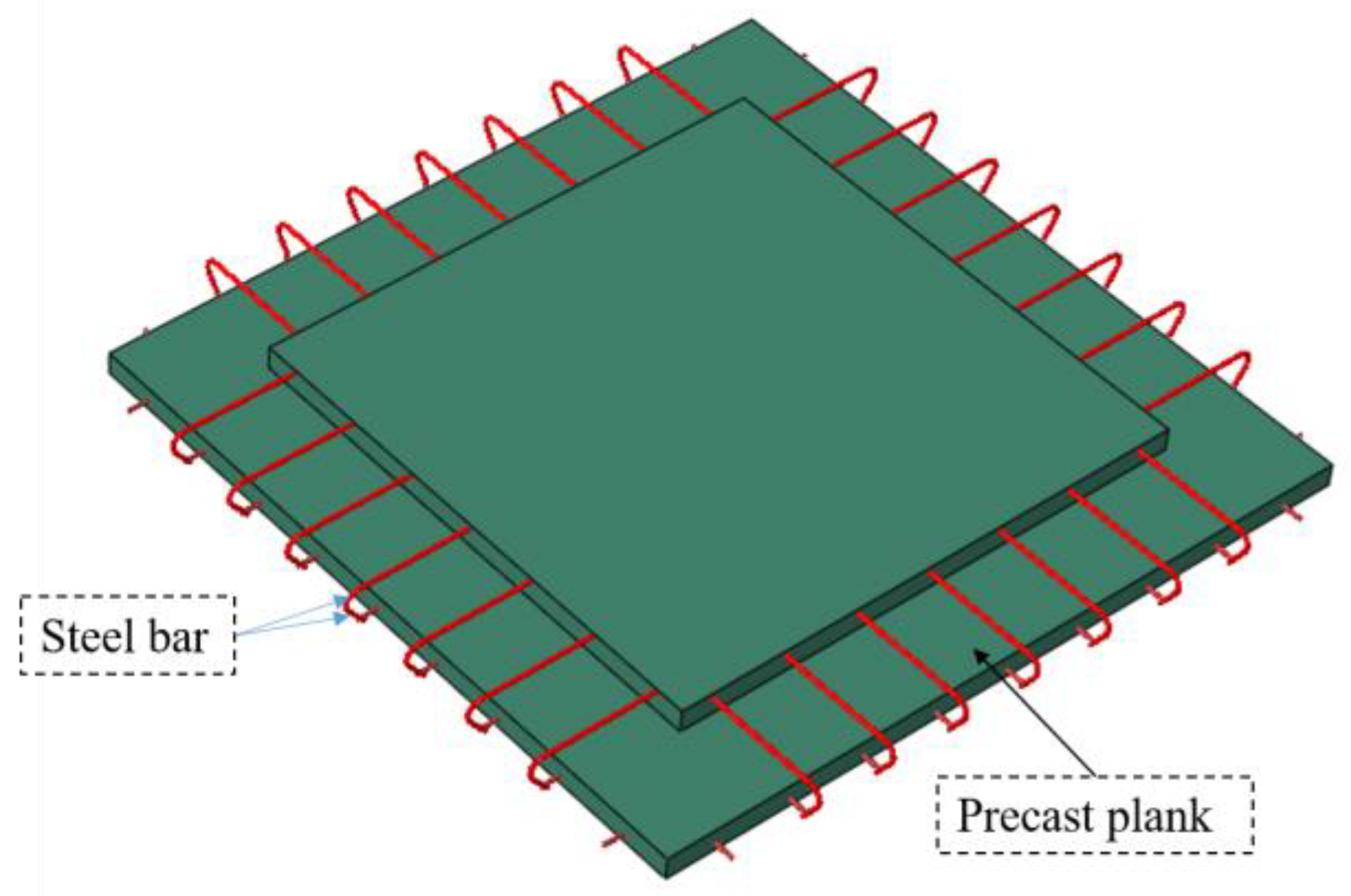
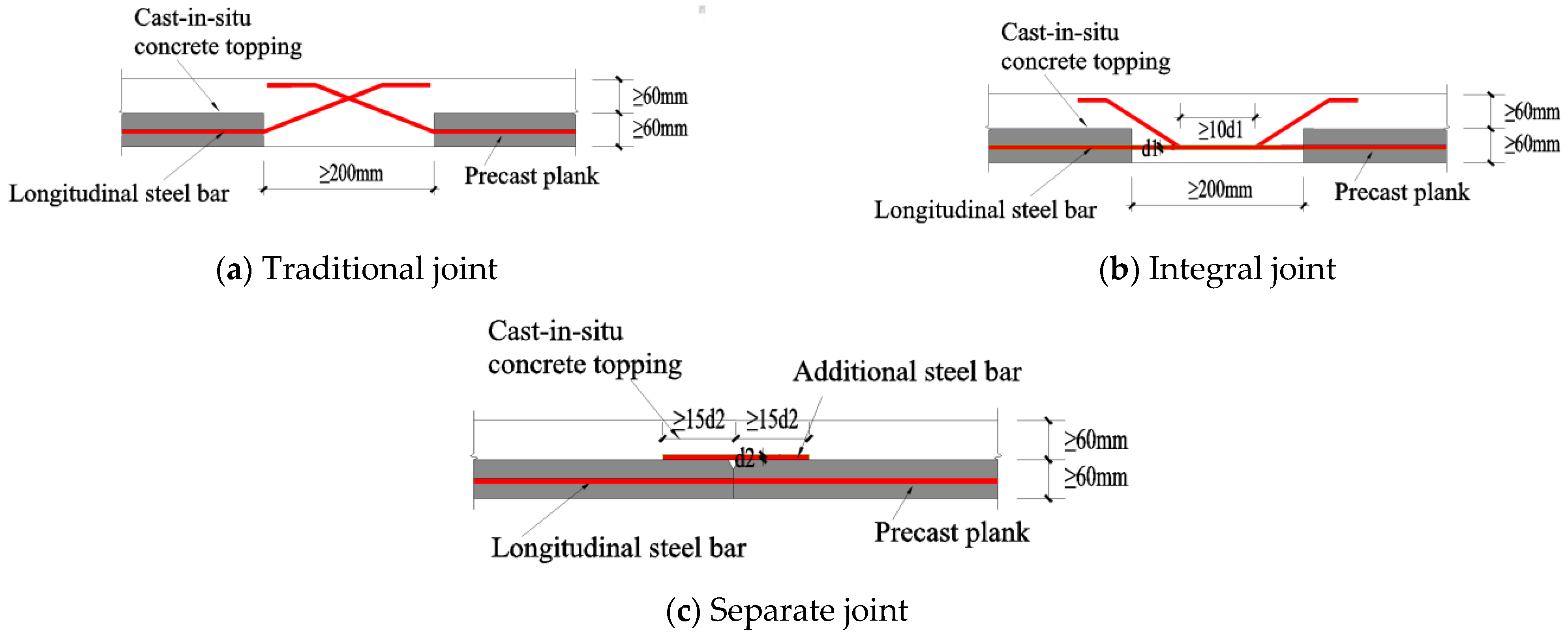
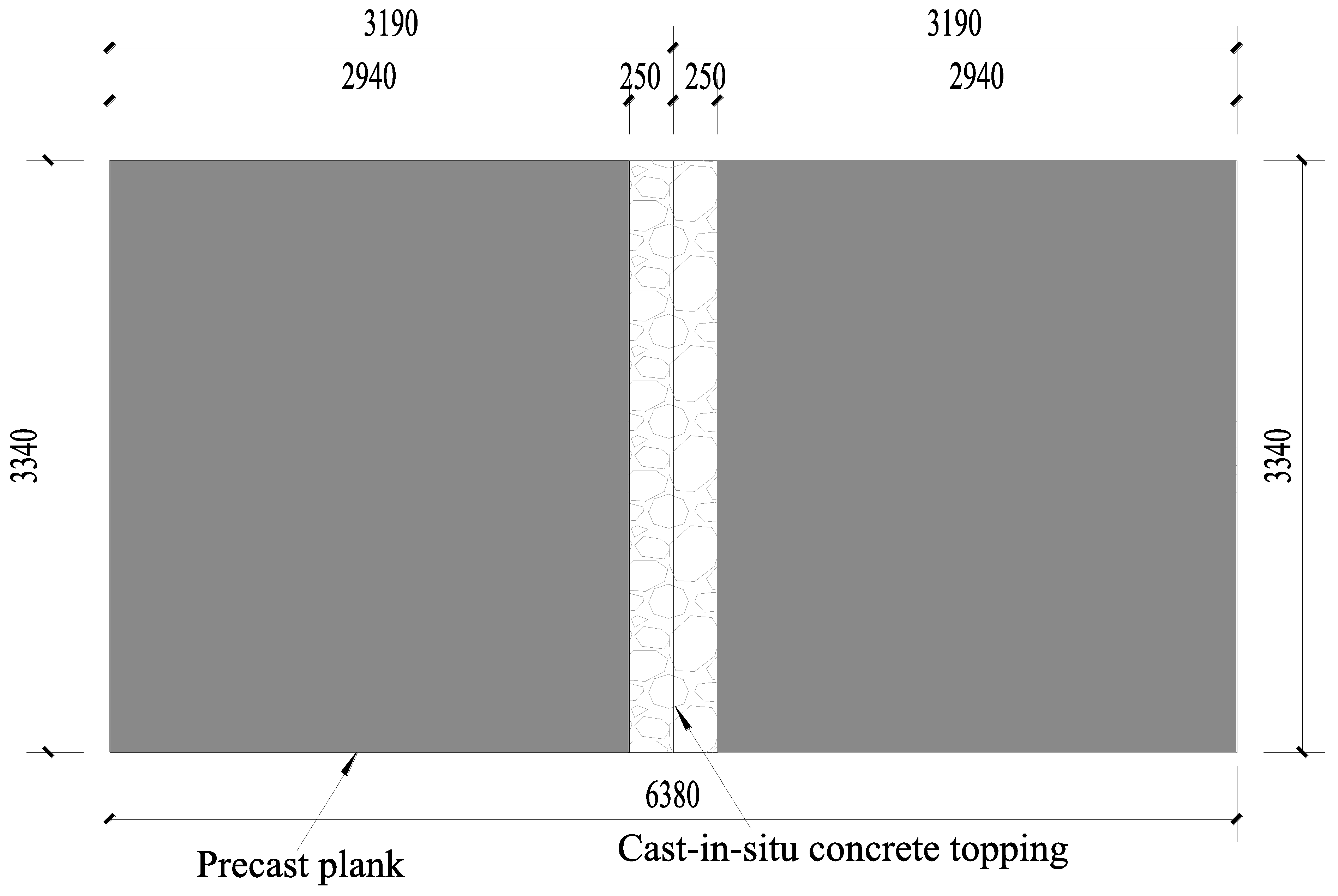


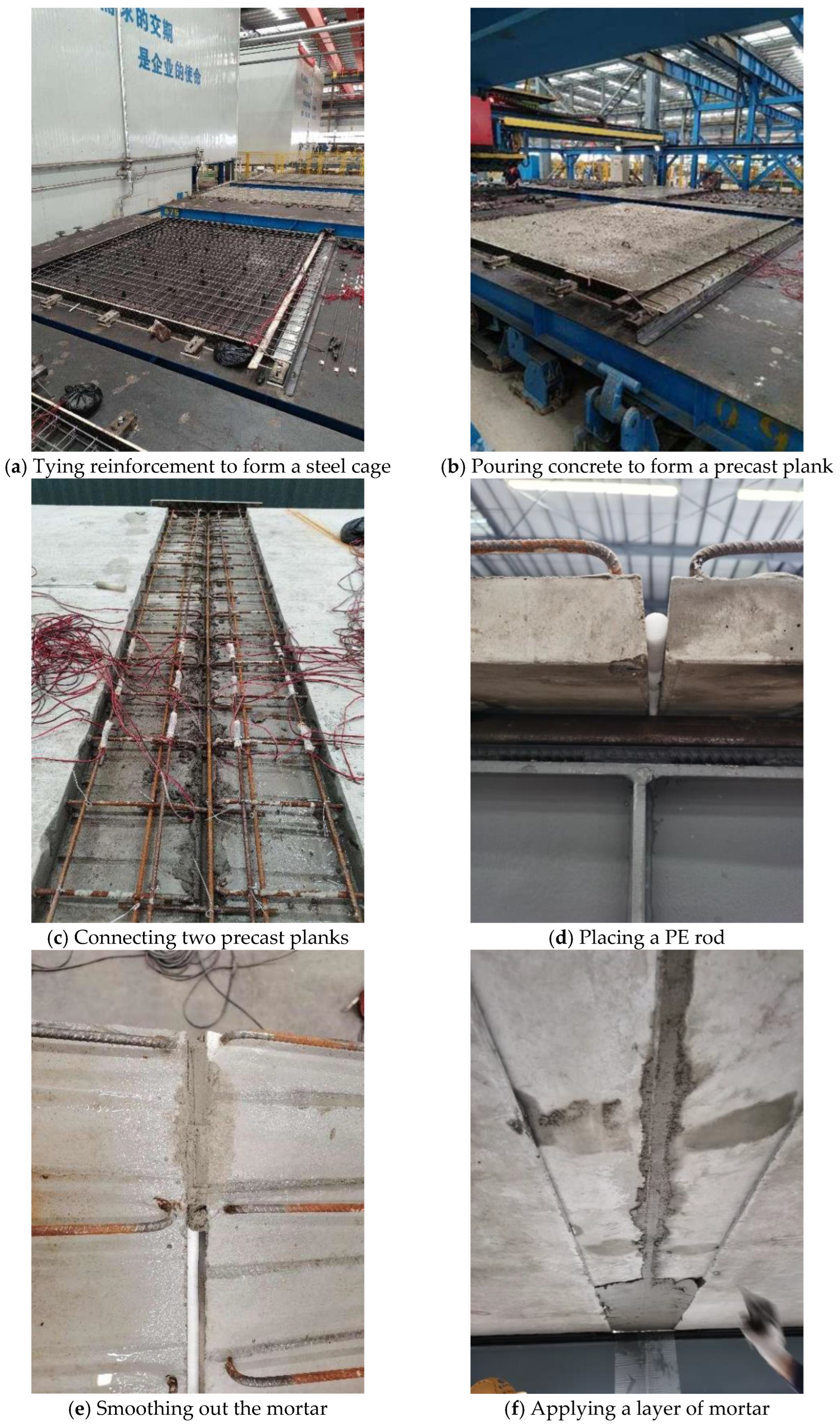
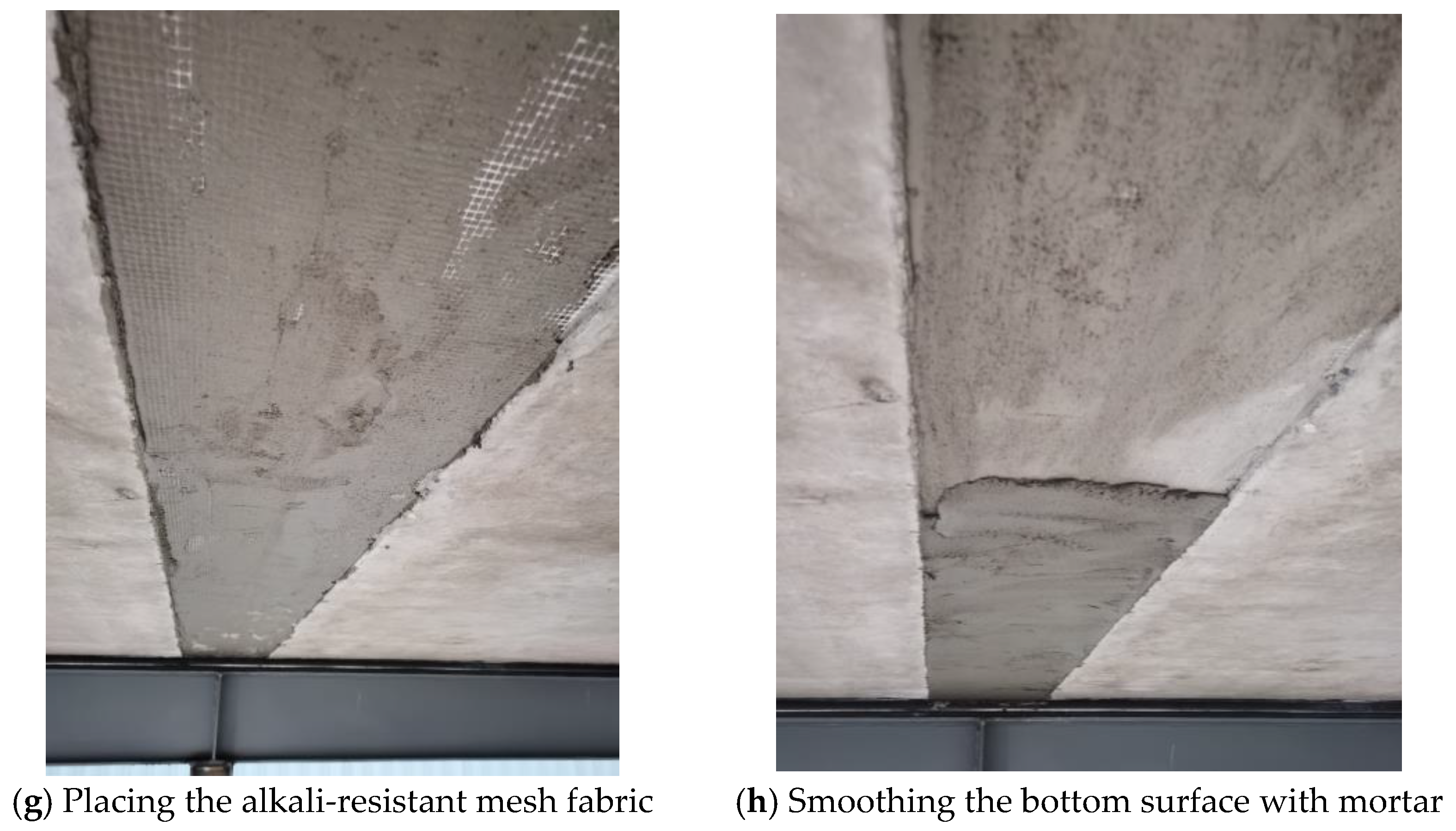
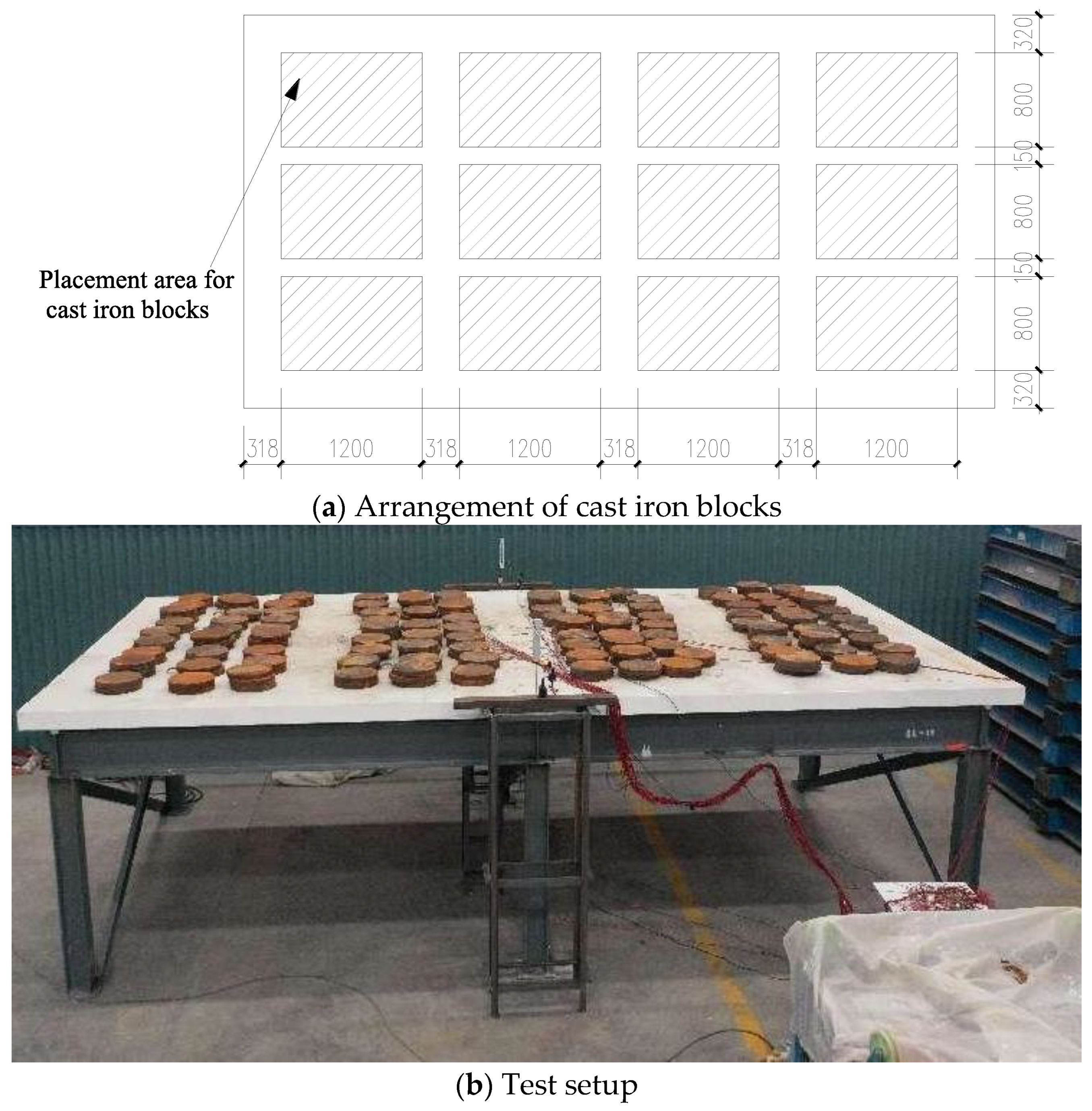

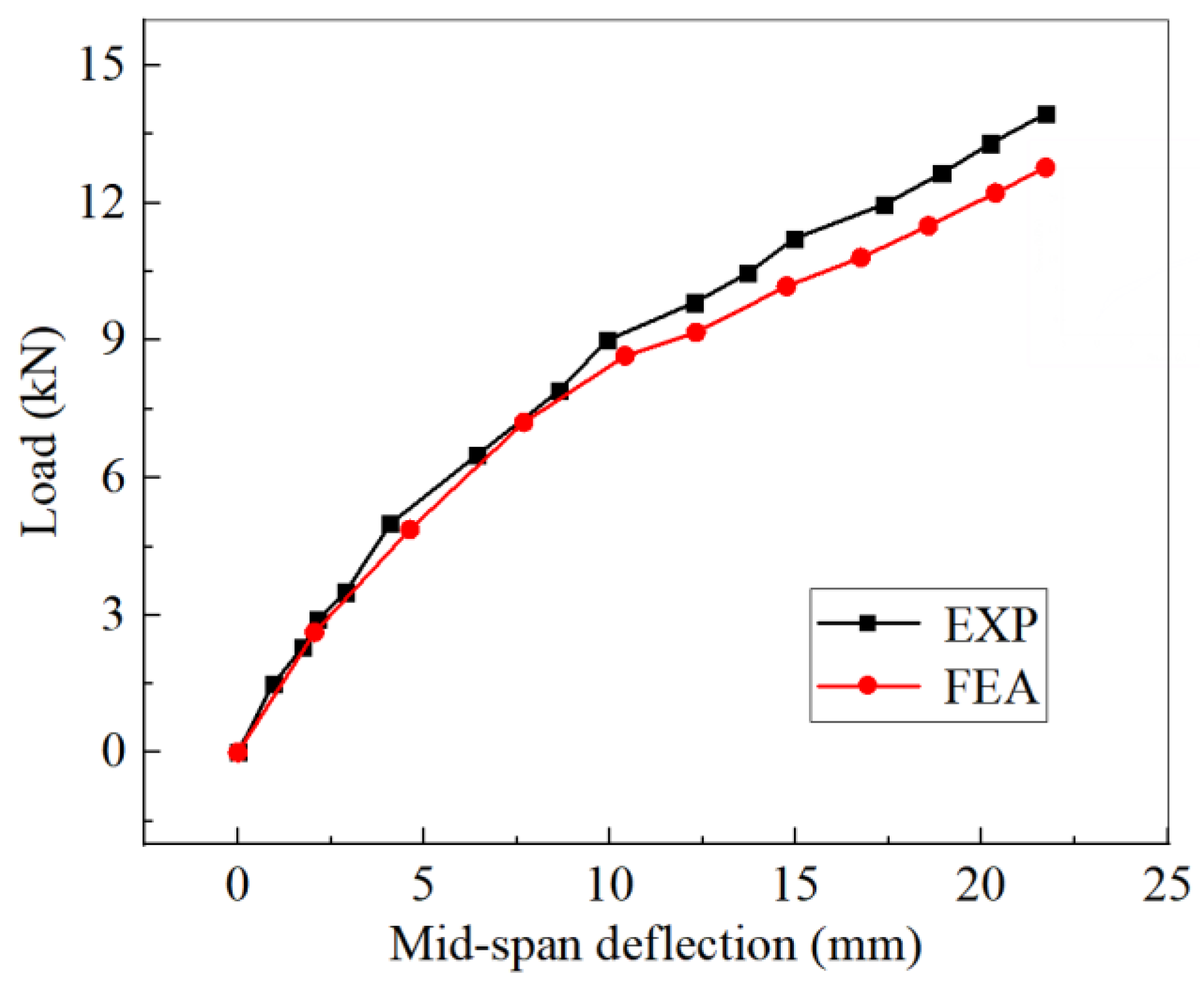
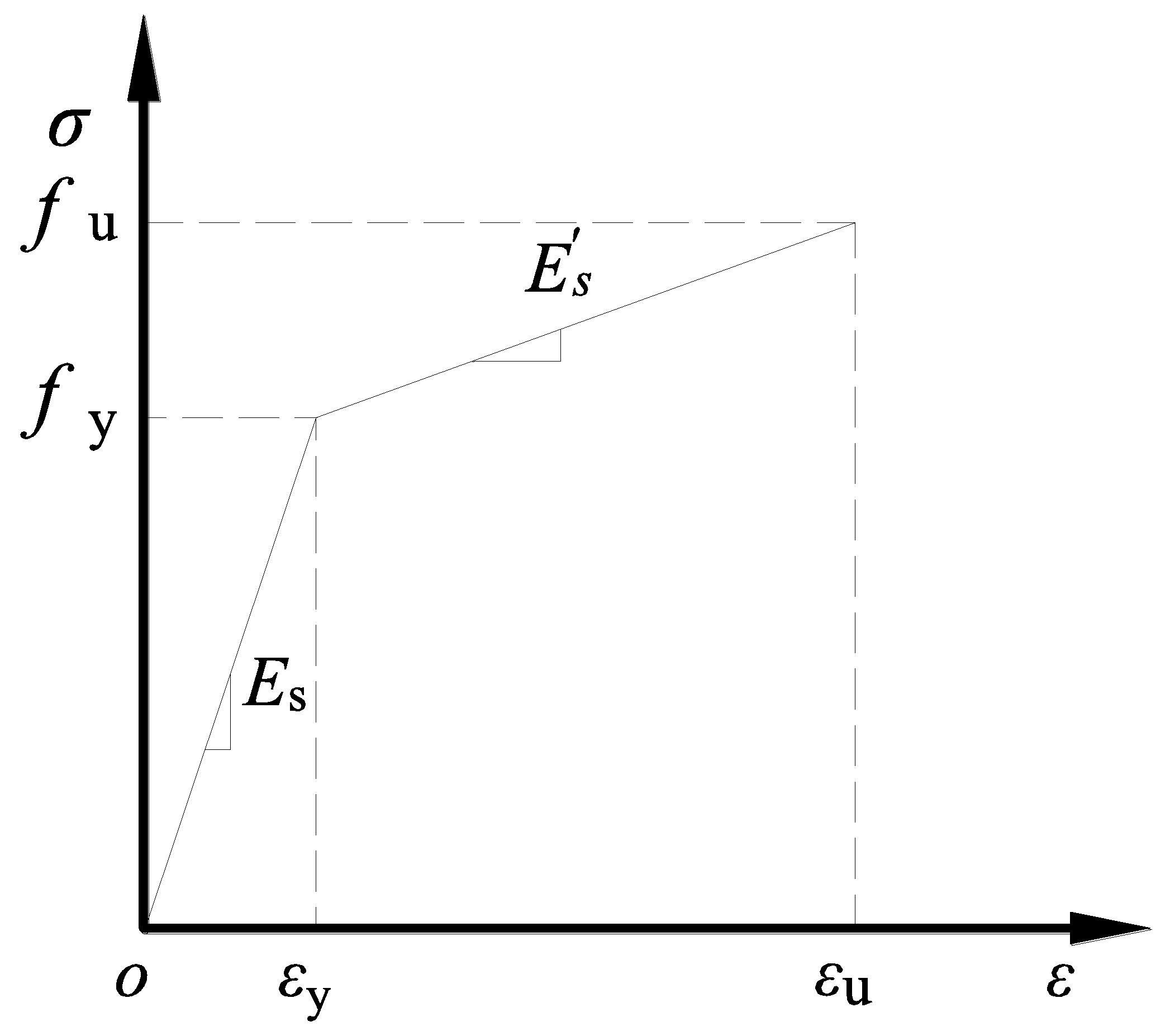


| Concrete | No. | Compressive Strength/MPa | Average Compressive Strength/MPa |
|---|---|---|---|
| Precast plank | 1 | 37.3 | 38.0 |
| 2 | 38.7 | ||
| 3 | 38.0 | ||
| Cast-in situ concrete topping | 4 | 46.6 | 46.0 |
| 5 | 46.2 | ||
| 6 | 45.2 |
| Member | Diameter (d)/mm | Elastic Modulus (Es)/GPa | Yielding Strength (fy)/MPa | Ultimate Strength (fu)/MPa |
|---|---|---|---|---|
| Steel bars | 8 | 196 | 525 | 688.5 |
| Loading Stage | Increment of Load per Stage (kN/m2) | Total Accumulated Load Value (kN/m2) | Loading Stage | Increment of Load per Stage (kN/m2) | Total Accumulated Load Value (kN/m2) |
|---|---|---|---|---|---|
| 0 | 0 | 0 | 8 | 1.1 | 9 |
| 1 | 1.5 | 1.5 | 9 | 0.82 | 9.82 |
| 2 | 0.8 | 2.3 | 10 | 1.47 | 10.47 |
| 3 | 0.6 | 2.9 | 11 | 0.75 | 11.22 |
| 4 | 0.6 | 3.5 | 12 | 0.75 | 11.97 |
| 5 | 1.5 | 5 | 13 | 0.75 | 12.65 |
| 6 | 1.5 | 6.5 | 14 | 0.68 | 13.3 |
| 7 | 1.4 | 7.9 | 15 | 0.65 | 13.95 |
| Architecture Categories | Fp (kN/m2) | Δ/mm | Crack Characteristics |
|---|---|---|---|
| Residential buildings | 2.3 | 1.74 | Concrete not cracked |
| Shops | 3.25 | 2.60 | Concrete not cracked |
| Storage rooms | 5.5 | 4.88 | Concrete cracking with crack width less than 0.3 mm |
Disclaimer/Publisher’s Note: The statements, opinions and data contained in all publications are solely those of the individual author(s) and contributor(s) and not of MDPI and/or the editor(s). MDPI and/or the editor(s) disclaim responsibility for any injury to people or property resulting from any ideas, methods, instructions or products referred to in the content. |
© 2024 by the authors. Licensee MDPI, Basel, Switzerland. This article is an open access article distributed under the terms and conditions of the Creative Commons Attribution (CC BY) license (https://creativecommons.org/licenses/by/4.0/).
Share and Cite
Chen, X.; Luo, B.; Liu, X. Experimental and Numerical Investigation of a New Type of Composite Slab with a Separate Joint. Buildings 2024, 14, 1890. https://doi.org/10.3390/buildings14071890
Chen X, Luo B, Liu X. Experimental and Numerical Investigation of a New Type of Composite Slab with a Separate Joint. Buildings. 2024; 14(7):1890. https://doi.org/10.3390/buildings14071890
Chicago/Turabian StyleChen, Xiulong, Bin Luo, and Xin Liu. 2024. "Experimental and Numerical Investigation of a New Type of Composite Slab with a Separate Joint" Buildings 14, no. 7: 1890. https://doi.org/10.3390/buildings14071890





